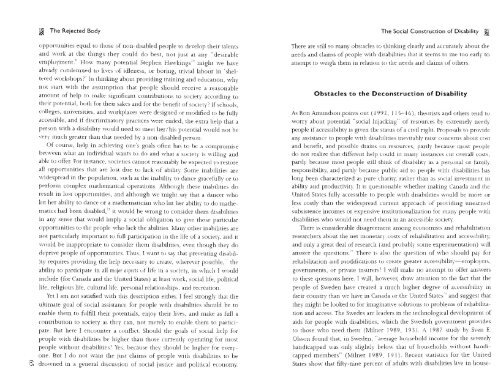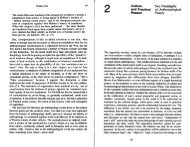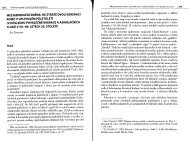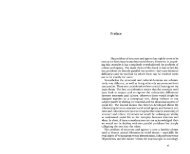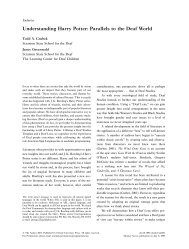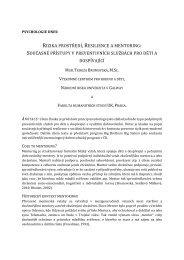The Social Construction of Disability - Moodle
The Social Construction of Disability - Moodle
The Social Construction of Disability - Moodle
Create successful ePaper yourself
Turn your PDF publications into a flip-book with our unique Google optimized e-Paper software.
~ <strong>The</strong> Rejected Bodyopportunities equal to those <strong>of</strong> non-disabled people to develop their talentsand work at the things they could do best, not just at any "desirableemployment." How many potential Stephen Hawkings" might we havealready condemned to lives <strong>of</strong> idleness, or boring, trivial labour in 'shelteredworkshops?' In thinking about providing training and education, whynot start with the assumption that people should receive a reasonableamount <strong>of</strong> help to make Significant contributions to society according totheir potential, both for their sakes and for the benefit <strong>of</strong> society? If schools,c0lleges, universities, and workplaces were designed or modified to be fullyaccessible, and if discriminatory practices were ended, the extra help that aperson with a disability would need to meet her/his potential would not bevery much greater than that needed by a non-disabled persoll.Of course, help in achieving one's goals <strong>of</strong>tell has to be a compromisebetween what an individual wants to do and what a society is willing andable to <strong>of</strong>fer. For instance, societies cannot reasonably he expected to restoreall opportunities that are lost due to lack <strong>of</strong> ability Some inabilities areWidespread in the population, such as the inability to dance gracefully or toperform complex mathematical operations. Although these inabilities doresult in lost opportunities, and although we might say that a dancer wholost her ability to dance or a mathematician who lost her ability to do mathematicshad been disabled," it would be wrong to consider them disabilitiesin any sense that would imply a social obligation to give those particularopportunities to the people who lack the abilities. Many other inabilities arenot particularly important to full participation in the life <strong>of</strong> a society, and itwould be inappropriate to consider them disabilities, even though they dodeprive people <strong>of</strong> opportunities. Thus, I want to say that preventing disabilityrequires providing the help necessary to create, wherever possible,' theability to participate in all major a,pec(s c;r life in a society. in which I wouldinclude (for Canada and the United States) at least work, social life, politicallife, religious life, cultural life, personal relationships, and recreation.Yet 1 am not satisfied with this description either. I feel strongly that theultimate goal <strong>of</strong> social assistance for people with disabilities should be toenable them to fulfill their potentials, enjoy their lives, and make as full acontribution to society as they can, not merely to enable them to participate.But here I encounter a conflict. Should the goals <strong>of</strong> social help forpeople with disabilities be higher than those curreutly operating fur mostpeople without disabilities.' Yes, because they should be higher for everyone.But I do not want the just claims <strong>of</strong> people with disabilities to be~ drowned in a general discussion <strong>of</strong> social justice and political economy.<strong>The</strong> <strong>Social</strong> <strong>Construction</strong> <strong>of</strong> <strong>Disability</strong> ~<strong>The</strong>re are still so many obstacles to thinking clearly and accurately about theneeds and claims <strong>of</strong> people with disabilities that it seems to me too early toattempt to weigh them in relation to the needs and claims <strong>of</strong> others.Obstacles to the Deconstruction <strong>of</strong> <strong>Disability</strong>As Ron Amundson points out (1992, 115-16), theorists and others tend toworry about potential "social hijacking" <strong>of</strong> resources by extremely needypeople if accessibiluy is given the status <strong>of</strong> a civil ngllt. Proposals to provideany assistance to people with disabilities inevitably raise concerns about costand benefit, and possible drains OIl resources, partly because must peopledo not realize that different help could in many instances cut overall costs,partly because most people still think <strong>of</strong> disability as a personal or familyresponsibility, and partly because public aid to people with disabilities haslong been characterized as pure charity, rather than as social investment inability and productivity It is questionable whether making Canada and theUnited States fully accessible to people with disabilities would be more orless costly than the Widespread current approach <strong>of</strong> providing unearnedsubsistence inC0111eS or expensive institutionalization for many people withdisabilities who would not need them in an accessible society.<strong>The</strong>re is considerable disagreement among economists and rehabilitationresearchers about the net monetary costs <strong>of</strong> rehabilitation and accessibility,and only a great deal <strong>of</strong> research (and probably some experimentation) willanswer the questions." <strong>The</strong>re is also the question <strong>of</strong> who should pay forrehabilitation and modifications to create greater accessibiliry-e-ernployers,governments, or private insurers J I will make no attempt to <strong>of</strong>fer answersto these questions here. I will, however, draw attention to the fact that thepeople <strong>of</strong> Sweden have created a much higher degree <strong>of</strong> accessibility intheir country than we have in Canada or the United States " and suggest thatthey might be looked to for imaginative solutions to problems <strong>of</strong> rehabilitationand access. <strong>The</strong> Swedes are leaders in the technological development <strong>of</strong>aids for people with disabilities, which the Swedish government providesto those who need them (Milner 1989,193). A 1987 study by Sven EOlsson found that, in Sweden, "average household income for the severelyhandicapped was only slightly below that <strong>of</strong> households without handicappedmembers" (Milner 198 9, I;) I). Recent statistics for the UnitedStates show that fifty-nine percent <strong>of</strong> adults with disabilities live in house


